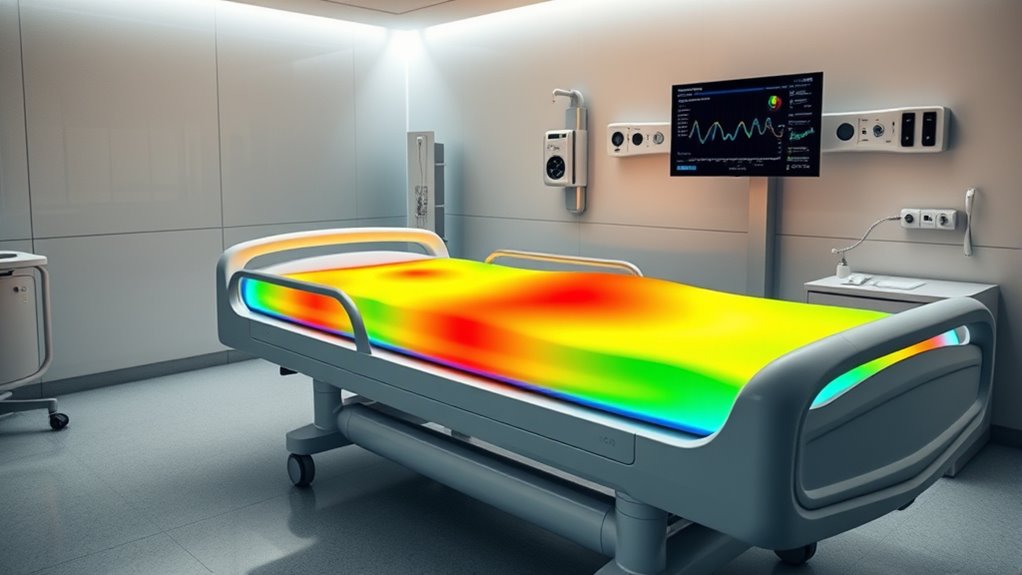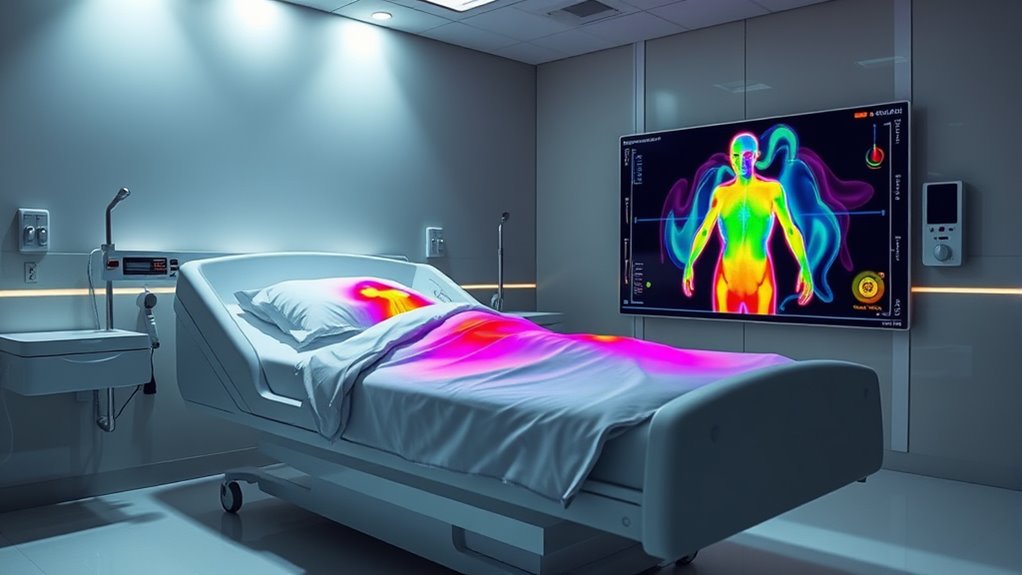Smart beds with pressure mapping track your body’s pressure points and movements to help prevent bedsores effectively. By analyzing pressure distribution in real time, these beds can automatically adjust to reduce sustained pressure on vulnerable areas. This technology improves comfort, promotes better sleep, and offers ongoing monitoring for at-risk individuals. Keep exploring to discover how this innovative solution can make bedsores a thing of the past and enhance overall health.
Key Takeaways
- Pressure mapping sensors in smart beds identify high-pressure zones to prevent skin breakdown and bedsores.
- Real-time data allows dynamic pressure redistribution, reducing prolonged pressure on vulnerable areas.
- Continuous monitoring helps caregivers detect early signs of pressure-related issues remotely and promptly.
- Personalized sleep and positioning adjustments optimize comfort and minimize bedsores risk.
- Integration with health systems enhances preventative care for at-risk patients in medical or long-term settings.

Have you ever wondered how technology is transforming the way we sleep? Today, smart beds equipped with pressure mapping technology are revolutionizing sleep comfort and health. These beds go beyond basic comfort features by actively monitoring your body’s position, pressure points, and movement throughout the night. It’s all about using data to prevent common issues like bedsores, improve sleep quality, and promote better health.
Pressure mapping involves sensors embedded in the mattress that detect how your body distributes weight while you sleep. When you lie down, these sensors create a detailed map of pressure points—areas where blood flow might be restricted if pressure is too high or sustained for too long. The data collected is then analyzed to identify problematic zones that could lead to discomfort or skin breakdown, especially for those with limited mobility or medical conditions. This real-time feedback allows the smart bed to make adjustments, such as redistributing pressure or prompting you to shift positions, reducing the risk of bedsores and other pressure-related issues.
Sensors in the mattress detect pressure points, helping prevent discomfort and skin breakdown through real-time adjustments.
Using smart beds with pressure mapping isn’t just about prevention; it’s about personalized sleep health. The data generated can be integrated with smartphone apps or health monitoring systems, providing insights into your sleep patterns and body movements. Over time, this information helps you understand how your body responds to different sleeping positions, mattresses, or even the ambient environment. With this knowledge, you can make informed choices to optimize your sleep setup, leading to deeper, more restorative rest.
For caregivers and medical professionals, pressure mapping in smart beds offers valuable tools to monitor at-risk patients continuously. Instead of relying solely on visual assessments or periodic checks, they can track pressure distribution patterns remotely, ensuring that patients maintain safe positions and receive timely interventions if pressure points become problematic. This technology is especially beneficial in long-term care facilities or hospitals, where preventing bedsores can considerably impact patient comfort, recovery, and overall health.
Ultimately, smart beds equipped with pressure mapping technology harness data to enhance sleep quality and health outcomes. They empower you to take an active role in managing your sleep environment and health, preventing issues before they escalate. Whether you’re seeking better rest or caring for someone vulnerable, this innovative use of data-driven technology transforms the way we approach sleep, making it safer, healthier, and more personalized. Additionally, incorporating pressure redistribution strategies can further optimize pressure relief and comfort for users.
Frequently Asked Questions
How Affordable Are Smart Beds for Home Use?
Smart beds for home use can be quite affordable, especially compared to hospital-grade models. Prices vary depending on features, but basic versions often start around $1,500 to $3,000. If you look for models with pressure mapping and other advanced features, expect to pay between $3,000 and $7,000. Many companies offer financing options or insurance coverage, making it easier for you to access these innovative beds without breaking the bank.
Can Pressure Mapping Technology Be Used in Non-Medical Settings?
Yes, pressure mapping technology can be used in non-medical settings. You can incorporate it into your home or office to monitor pressure points, improve comfort, and prevent discomfort. Whether you’re adjusting your chair, mattress, or seating arrangement, pressure mapping provides real-time data. This helps you make better decisions, enhance relaxation, and avoid long-term issues, making everyday environments safer and more comfortable for everyone.
What Are the Maintenance Requirements for Pressure Mapping Systems?
You need to regularly clean pressure mapping sensors with a damp cloth and avoid harsh chemicals to keep them accurate. Check the system’s calibration weekly and update software as recommended by the manufacturer. Inspect cables and connections for damage, and make certain the system is stored in a dry, dust-free environment when not in use. Proper maintenance ensures reliable data collection and extends the lifespan of your pressure mapping system.
Are There Privacy Concerns With Data Collected by Smart Beds?
Think of smart beds as silent guardians, but even guardians have secrets. You might worry about privacy, and it’s valid—these beds collect sensitive health data. To protect your privacy, guarantee data encryption and strict access controls are in place. Regularly review privacy policies and stay informed about how your data’s used. With proper safeguards, your personal information stays secure while you benefit from advanced pressure management.
How Long Does It Take to See Benefits After Implementing Smart Beds?
You can start seeing benefits within days to a few weeks after implementing smart beds. As soon as the system begins monitoring pressure points and adjusting support accordingly, you’ll notice improved comfort and reduced risk of bedsores. Consistent use and proper staff training enhance results, making it easier to identify issues early. Over time, these proactive adjustments lead to better patient outcomes and overall comfort.
Conclusion
Imagine a future where your bed becomes a vigilant guardian, quietly watching over your comfort like a gentle sentinel. With smart beds and pressure mapping, you’re not just resting—you’re dancing with data to beat bedsores before they even appear. This innovative duo acts as a lighthouse in the fog of immobility, guiding you safely to healthier, happier days. Embrace the technology that turns your bed into a fortress of care, safeguarding your well-being with every pause and shift.









